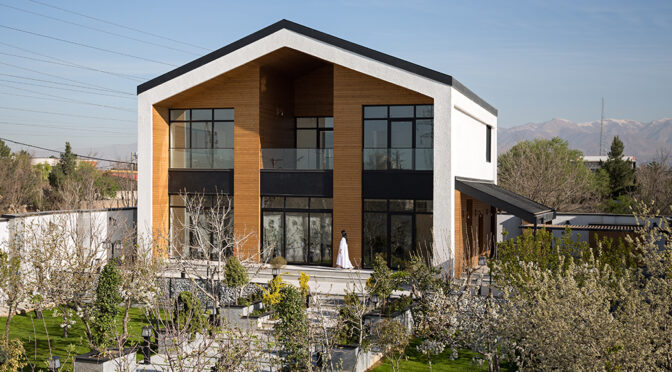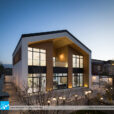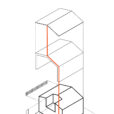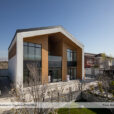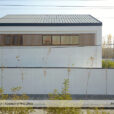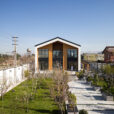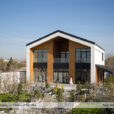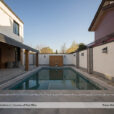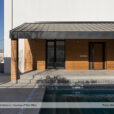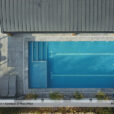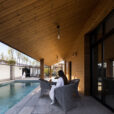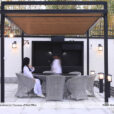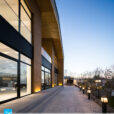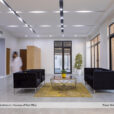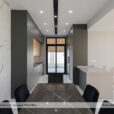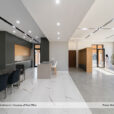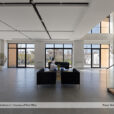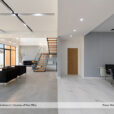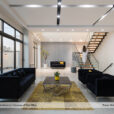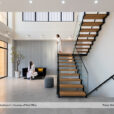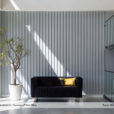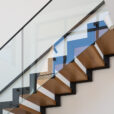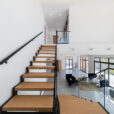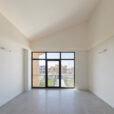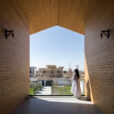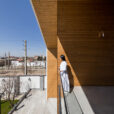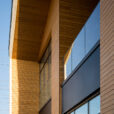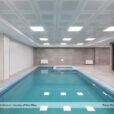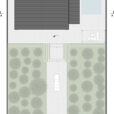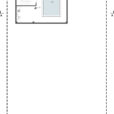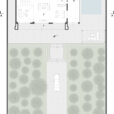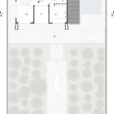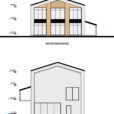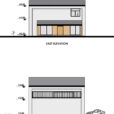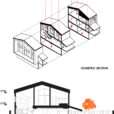ویلای بافتار
دفتر معماری اول (علی کاظمی)
موقعیت: کردان، البرز، ایران
تاریخ: ۱۳۹۹
مساحت: ۴۵۰ مترمربع
وضعیت: ساختهشده
کارفرما: آقای انواری
گرافیک و ارائه: فاطمه بنایی
عکس: محمدحسن اتفاق
با ایدهای از خانههای ساده کودکانه، و برای پاسخ به نیازهای عملکردی کارفرما، فرم پروژه را در سادهترین حالت ایجاد کردیم. از گذشتههای دور، «خانه» در معماری، به عنوان محلی برای آرامش تعریف میشد؛ ایده خانههای کودکانه نیز در راستای نایلشدن به طراحی فضایی آرامشبخش، نقشی مهم را ایفا کرد، چرا که یکی از راههای ایجاد فضاهای مطلوب از نظر روحی و معنوی، بهکارگیری فرمهای آشنا برای ذهن است. ما با بهرهگیری از این ایده جذاب، استفادهکننده از فضا را به دنیای کودکی خود هدایت کردیم تا کمی از هیاهوهای دنیای مدرن امروزی فاصله گیرد.
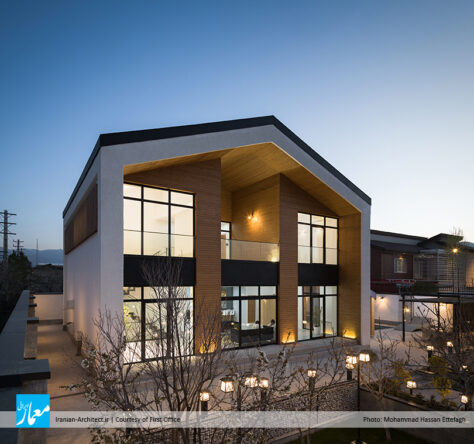
«بافتار» همانگونه که از اسم آن برمیآید، از درآمیختن بافتهای متنوع و مختلف پدید آمده است. ما در این پروژه سعی کردیم ساختار بنا را تحت تاثیر بافت متریالها قرار دهیم؛ چوب، سیمان سفید، سنگ و فلز در هم تنیده شده، و همانند تاروپود یک قالی، پوسته خارجی ساختمان را در برگرفتهاند. حتی اگر چشمانتان را ببندید و از قوه بینایی خود استفاده نکنید، کافی است تنها با انگشتان خود پیکر ساختمان را نوازش کنید؛ تنوع متریالها و بافت منحصربهفردشان، بهراحتی قابل لمس است. بافت تگرگی سیمان سفید، خطوط پیوسته قطعات چوب، سقف شیبدار با خطوط تکرارشونده، و ایجاد شیار در سنگ پلاک، بخشی از تلاش ما برای نمایش ساختاری از جنس بافت در این بنا هستند.
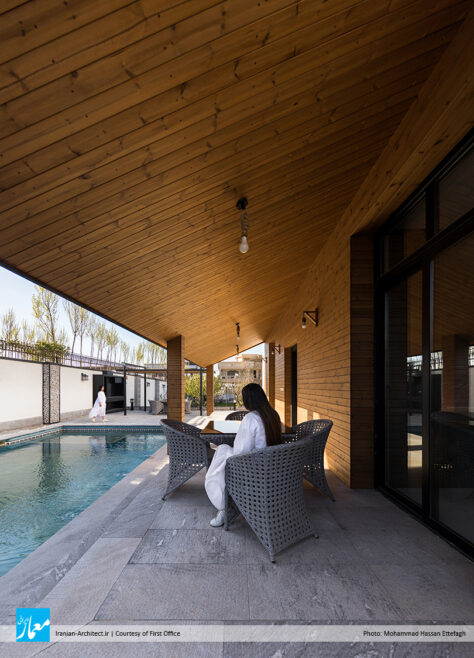
در انتخاب مصالح ویلا، توجه ویژهای به هماهنگی و سازگاری آنها با محیط پیرامونشان شده است و متریالهایی که خود از دل طبیعت به دست میآیند، برگزیده شدهاند. همچنین استفاده از چوب کمک شایانی به تحقق هدف پیوند سازه با طبیعت کرده است.
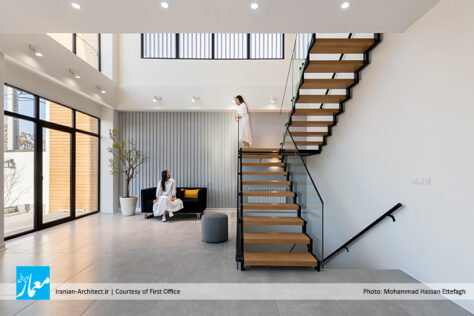
بافتار در سه سطح ارتفاعی طراحی شده است که دسترسی به آنها از طریق یک راهپله که در ضلع غربی ساختمان واقع شده، امکانپذیر است. در کنار نقش عملکردی پله، سعی ما بر ارائه آن به عنوان یک المان جذاب و چشمگیر بود که در طراحی داخلی خودنمایی کند، عنصری شاخص که بر روی جذابیتهای بصری فضاها تاثیر بهسزایی بگذارد، و تنها راهی برای گذر از طبقات محسوب نشود، و علاوه بر کارکردهای بهینهاش، به لحاظ زیباییشناسی، به بخش جداییناپذیر دکوراسیون داخلی مبدل شود. برای طراحی راهپله، از چوب و فولاد استفاده کردیم، دو متریالی که ترکیب جذابی را تشکیل میدهند و هنگامی که در کنار هم قرار بگیرند، میتوانند خوش بدرخشند. بافت چوب و فولاد با رنگهای مختص به خود، تفاوت قابلتوجهی در دیوارها و کف ایجاد و آنها را از یکنواختی خارج کرده است. کفپلههای مستحکم چوبی را نیز به وسیله فولاد مهار و به سازه اصلی متصل کردیم تا ضمن داشتن جلوه ظاهری دلپذیر و گیرا، دارای استحکام و مقاومت خوبی باشند و به فردی که قصد عبور از این معبر را دارد، حس امنیت را القا کنند.
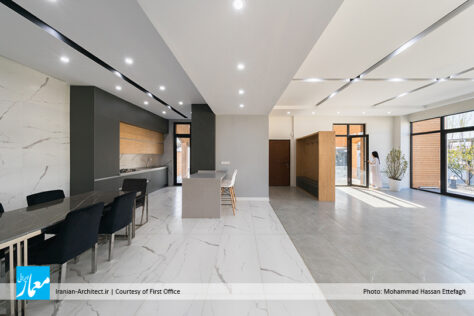
در طراحی فضاهای داخلی، مفاهیم «خلوت و تنهایی» و «معاشرت و همنشینی»، و فراهمکردن بستری برای دستیابی به آنها، و همچنین تفکیک فضاهای شخصی و جمعی را مد نظر قرار دادیم، بهگونهای که اتاقهای خواب را بهصورت مجزا در طبقه اول جانمایی کردیم، اختصاص یک طبقه مستقل که نیاز استفادهکنندگان به داشتن یک حریم شخصی را بهخوبی برآورده میکند. پیرو همین رویکرد، فضاهایی نظیر سالن و غذاخوری که در آنها به معاشرت و ارتباطات جمعی پرداخته میشود، در طبقه همکف در نظر گرفته شدند.
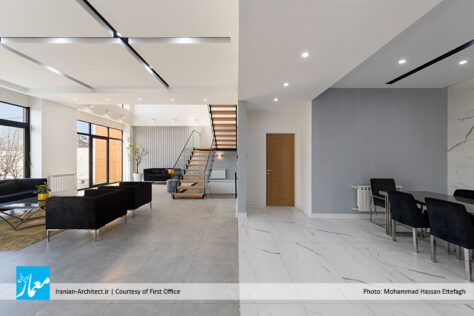
انتخاب متریال برای عناصر فضاهای داخلی، همسو و همراستا با مصالح بهکاررفته در پوسته خارجی بنا انجام گرفته است، بهگونهای که تونالیته رنگها در داخل و خارج هماهنگی دارند، و همانند نما، شاهد کنار هم قرار گرفتن بافتهای مختلف در داخل بنا نیز هستیم.
Baaftaar Villa
First Office (Ali Kazemi)
Location: Kordan, Alborz, Iran
Date: 2020
Area: 450 sqm
Status: Completed
Client: Mr. Anvari
Graphic & Presentation: Fatemeh Banaei
Photo: Mohammad Hassan Ettefagh
With the idea of children’s simple homes, and responding to the functional needs of the client, we created the project form in the simplest form. From time immemorial, the architectural concepts of “home” have been defined as a place of relaxation. The idea of children’s homes played an important role in achieving a calming space design; because one of the ways to create desirable spaces emotionally and spiritually, is to use familiar forms for the mind. Using this fascinating idea, we guided the user of space to their childhood world, to get away from the hustle and bustle of today’s modern world.
Baaftaar, as its name implies, arose from the fusion of diverse and different textures. In this project, we tried to influence the structure of the building with the texture of the material, and Baaftaar was created. Wood, white cement, stone and metal are intertwined and surrounded the outer shell of building, like carpet’s warp and weft. Even if you close your eyes, and do not use your eyesight, it is enough to caress the body of the building with your fingers only; the variety of materials and their unique texture are easily palpable. The hail texture of white cement, the continuous lines of pieces of wood, the sloping roof with repetitive lines, and the creation of grooves in the palate stone, are part of our effort to display a textured structure in this building.
In the selection of materials, special attention has been paid to their harmony and compatibility with their surroundings, and the materials that are obtained from the heart of nature, have been selected. Using of wood has helped to achieve the goal of linking the structure with nature.
The plan is highly readable, and the interior spaces are cleverly divided. In the villa, after passing the pre-entrance, we first reach a directly divided space; the space that is located in the center of the building, and has the status of connecting the different parts of the ground floor, including the hall, kitchen, guest room, and access to different floors. The hall overlooks the outdoor pool from the east side, and the view from the south side of the hall is the garden green space.
The villa is designed in three levels, which can be accessed by a staircase located on the west side of the building. In addition to its functional role, we tried to present the stairs as an attractive and impressive element that stands out in the interior design; an indicator element that has a great impact on the visual appeal of the spaces, and is not the only way to cross the floors, and in addition to its optimal functions, aesthetically, becomes an integral part of interior decoration. To design the staircase, we used wood and steel, two materials that form an attractive combination, and can shine brightly when placed together. The texture of wood and steel with its own colors, has made a noticeable difference in the walls and floor, and makes them out of uniformity. We restrained the solid wooden stair treads with steel, and attached them to the main structure; so that while having a pleasant and attractive appearance, it also has good strength and resistance, and instills a sense of security in the person who intends to cross this passage.
In designing the interior spaces, we considered the concepts of “privacy and solitude”, and “companionship”, and providing a platform for achieving them, as well as the separation of personal and collective spaces. So that, we located the bedrooms separately, and on the first floor; assign an independent floor that meets the needs of users, to have a good privacy. Following this approach, spaces such as the lounge and dining area where socializing and communicating are discussed, were considered on the ground floor.
The choice of materials for the elements of interior spaces is in line with the materials used in the exterior shell of the building. The tonality of the colors is in harmony inside and out, and like the facade, we see different textures coming together inside the building.

